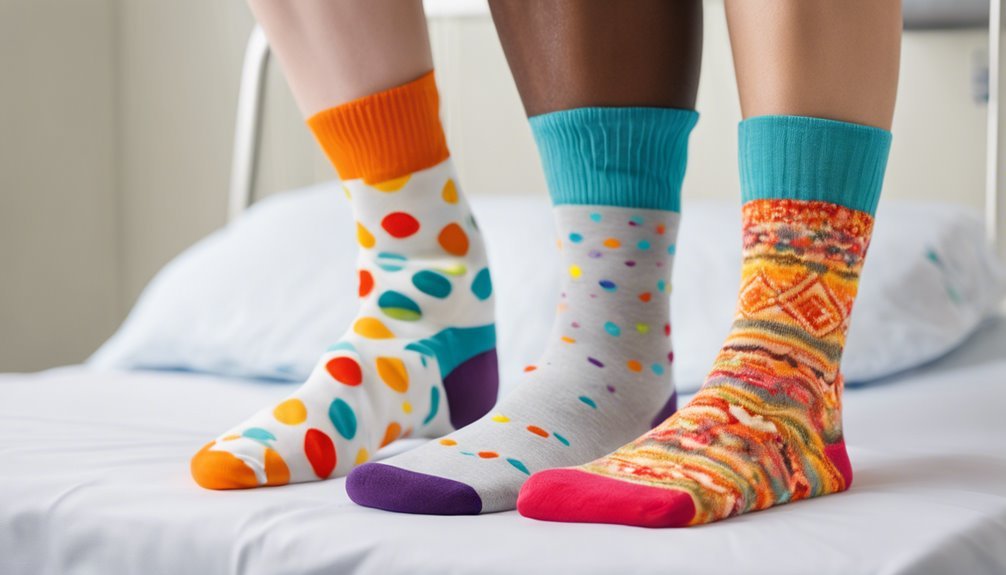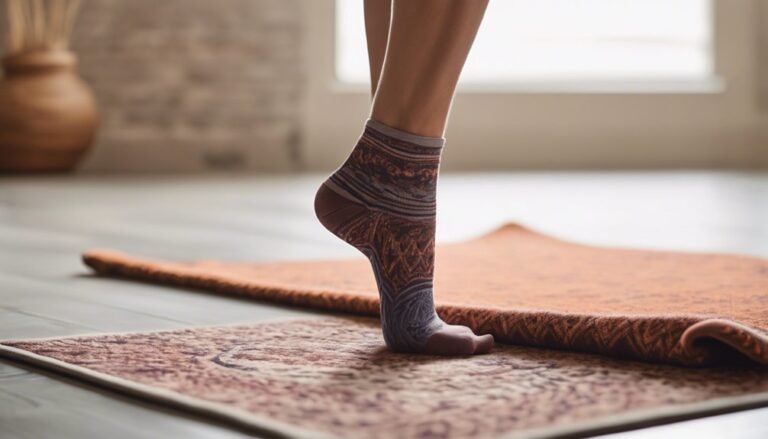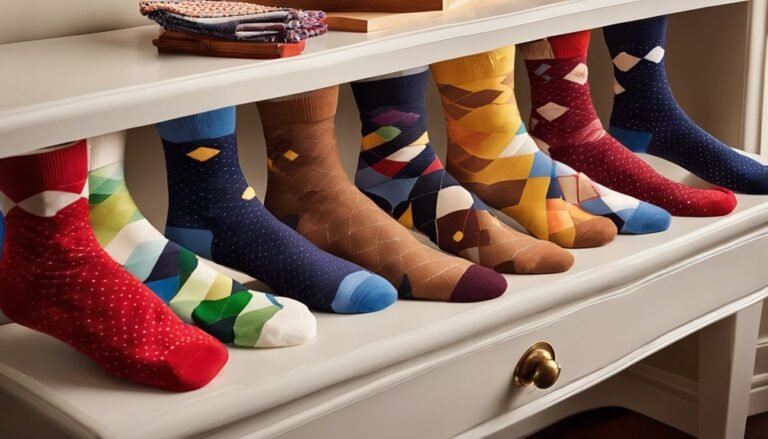Hospital Socks vs. Regular Socks: What’s the Purpose of Grip Socks?
Hospital socks, or grip socks, are specially designed for patient safety and comfort. Unlike regular socks, they feature slip-resistant soles that provide traction on slippery surfaces, greatly reducing fall risks. Made from breathable materials, grip socks wick moisture away and keep your feet comfortable during prolonged wear. Their snug fit guarantees they stay in place, promoting stability. There's much more to explore about their benefits and features, so let's uncover the full story behind grip socks.
Understanding Hospital Socks

Hospital socks, often referred to as grip socks, are specially designed to enhance safety and comfort for patients. These socks typically feature non-slip soles, helping to prevent falls in slippery hospital environments. Made from breathable hospital sock materials like cotton or polyester blends, they offer comfort while ensuring durability. You'll find that patient sock regulations often dictate their use in medical settings, ensuring each pair meets specific safety standards. These regulations not only prioritize your safety but also help maintain hygiene within healthcare facilities. By understanding these elements, you can appreciate why grip socks are essential during your hospital stay, providing both freedom of movement and reducing the risk of accidents.
The Design of Grip Socks
When considering the design of grip socks, it's important to recognize their unique features that set them apart from regular socks. The grip pattern is a key element, often made from rubber or silicone materials that enhance traction on slippery surfaces. This design not only promotes safety but also provides comfort during movement. Additionally, material selection plays a significant role; grip socks typically use breathable fabrics that wick moisture away, ensuring your feet stay dry and comfortable.
| Feature | Grip Socks | Regular Socks |
|---|---|---|
| Grip Pattern | Yes | No |
| Material | Breathable | Varies |
| Traction | High | Low |
| Purpose | Safety | Comfort |
| Fit | Snug | Loose |
Benefits of Grip Socks in Healthcare
In healthcare settings, grip socks offer essential benefits that enhance patient safety and comfort. These specialized socks improve patient mobility by providing traction on slippery surfaces, reducing the risk of falls. When you're recovering or undergoing treatment, maintaining your independence is crucial, and grip socks help you move around confidently.
Additionally, grip socks play a significant role in infection prevention. Many hospitals utilize materials that are more resistant to bacteria, minimizing the risk of hospital-acquired infections. Plus, they often allow for better air circulation, which can further reduce moisture buildup and related issues. By choosing grip socks, you're not only prioritizing your safety but also supporting a healthier environment within healthcare facilities.
How Regular Socks Differ From Hospital Socks

While regular socks serve a variety of everyday purposes, hospital socks are specifically designed to meet the unique needs of patients. Regular socks are often made from cotton or wool, focusing on comfort and style for daily wear. In contrast, hospital socks utilize specialized sock materials, like synthetic blends, to enhance durability and moisture-wicking properties. You'll find that hospital socks often feature unique designs catering to patient preferences, like non-slip grips, to promote safety in a clinical environment. The fit and functionality of hospital socks prioritize stability and ease of movement, unlike regular socks, which primarily emphasize aesthetics and casual comfort. Understanding these differences can help you appreciate the specific roles each type of sock plays in both everyday and healthcare settings.
Safety Features of Grip Socks
When it comes to safety, grip socks offer enhanced traction and stability that regular socks can't match. Their slip-resistant material helps prevent accidental falls, especially on slick surfaces. This added security makes grip socks a smart choice for various activities, from yoga to walking around the house.
Enhanced Traction and Stability
Grip socks are designed to provide enhanced traction and stability, making them a safer choice for various activities. With their unique grip patterns, these socks offer traction enhancement, guaranteeing you can move confidently on slippery surfaces. Whether you're in a hospital setting or engaging in yoga, the stability improvement they provide helps prevent slips and falls, allowing you to focus on your movement without worry. You'll appreciate how grip socks give you the freedom to engage in activities that require balance and agility. Plus, their snug fit guarantees they stay in place, further enhancing your safety. When you prioritize traction and stability, grip socks become an essential part of your wardrobe for any environment.
Slip-Resistant Material Benefits
The slip-resistant materials used in grip socks provide essential safety features that set them apart from regular socks. With advanced slip resistant technology, these socks enhance your stability, greatly reducing the risk of slips and falls. Whether you're maneuvering a hospital floor or just lounging at home, the grip guarantees you stay grounded.
Moreover, grip socks are designed for material durability, allowing them to withstand frequent use without losing their effectiveness. Unlike regular socks that can quickly wear out, the robust construction of grip socks guarantees they maintain their slip-resistant qualities over time. This combination of safety and durability gives you the freedom to move confidently in various environments, making grip socks a smart choice for anyone seeking both comfort and security.
Use Cases for Hospital Socks
While you might not think about it often, hospital socks play a crucial role in patient care and safety. These specially designed socks enhance patient mobility by providing grip on slippery hospital floors, reducing the risk of falls. They're particularly useful for patients recovering from surgery or those with limited mobility, as the added traction allows for safer movement. Additionally, hospital socks contribute to infection control; many are made from materials that minimize the risk of bacterial growth, helping to keep patients healthy during their stay. By using hospital socks, you not only improve your own safety but also adhere to hospital protocols that prioritize your well-being. So, next time you put them on, remember their significance in your recovery.
The Importance of Comfort in Patient Care
Comfort is essential in patient care, as it directly impacts recovery and overall well-being. When you're comfortable, it boosts your emotional wellness, allowing for a more positive healing environment. Hospitals can often feel sterile and intimidating, but prioritizing patient comfort can make a significant difference in your experience. Comfortable socks, like grip socks, not only keep your feet warm but also reduce the risk of slips and falls, helping you feel secure. This level of comfort can ease anxiety and promote relaxation, which is crucial for healing. Ultimately, when comfort is emphasized, it leads to better patient outcomes, as you're more likely to engage positively with your care team and adhere to recovery plans.
Choosing the Right Socks for a Clinical Environment

When choosing socks for a clinical environment, safety is paramount. Grip socks can provide added traction, reducing the risk of slips and falls, while also enhancing comfort and mobility for patients. It's essential to take into account both safety features and the overall comfort to guarantee ideal care.
Safety in Healthcare Settings
In healthcare settings, choosing the right socks is essential for enhancing safety and preventing slips and falls. Grip socks, designed with non-slip soles, greatly improve patient safety by providing better traction on often slippery hospital floors. When selecting socks, consider how they contribute to infection control as well. Regular socks can harbor bacteria, while specialized hospital socks are often made from materials that resist microbial growth. This not only protects patients but also helps maintain a clean environment for everyone. By opting for appropriate footwear, you're not only ensuring your own safety but also supporting the overall health of the clinical setting. Remember, every detail counts in creating a safer healthcare experience for all.
Comfort and Mobility Benefits
Choosing the right socks can greatly enhance your comfort and mobility in a clinical environment. Grip socks, specifically designed for healthcare settings, provide essential mobility improvement. Their non-slip bottoms help you maintain stability while walking on smooth floors, reducing the risk of falls. This added grip not only boosts your confidence but also allows for more freedom of movement.
Additionally, grip socks are often made from soft, breathable materials, contributing to comfort enhancement during long hours of wear. Unlike regular socks, they don't bunch or slide down, ensuring a snug fit that supports your feet throughout the day. By prioritizing comfort and mobility, you can focus on your recovery or care without unnecessary distractions.
Future Innovations in Hospital Sock Design
As hospitals increasingly prioritize patient safety and comfort, future innovations in hospital sock design are set to revolutionize the way we think about this essential garment. Expect to see advancements that incorporate smart textiles and antimicrobial properties, enhancing both functionality and hygiene. Here are three exciting innovations on the horizon:
- Adaptive Fit Technology: Socks that adjust to your foot shape for maximum comfort and support.
- Integrated Sensors: Smart socks that monitor temperature and circulation, providing real-time data to healthcare providers.
- Eco-Friendly Materials: Sustainable fabrics that offer durability and breathability while reducing environmental impact.
These innovations promise to make hospital socks not just functional, but a key component in enhancing your overall hospital experience.
Frequently Asked Questions
Can Grip Socks Be Washed and Reused Multiple Times?
You'll feel like a sock superhero! Yes, grip socks can be washed and reused, but keep durability concerns in mind. Follow these laundering tips: wash gently, avoid bleach, and air dry for longevity.
Are Grip Socks Available in Different Sizes and Colors?
Yes, grip socks come in various sizes and have multiple color options. You can easily find a pair that fits your style and needs, ensuring both comfort and a touch of personal expression.
Do Grip Socks Help With Foot Odor?
Imagine a knight protecting his castle from invaders; grip socks serve a similar purpose for your feet. They promote foot hygiene and odor prevention, ensuring your feet stay fresh and comfortable, ready for any adventure.
Can Grip Socks Be Worn Outside of Healthcare Settings?
Yes, you can definitely wear grip socks outside healthcare settings! They can make a fun fashion statement while providing traction for outdoor activities, offering both style and functionality for your adventures. Enjoy your freedom of movement!
Are There Any Specific Materials Used in Grip Sock Production?
Grip socks often use a blend of cotton, polyester, and elastane for comfort and stretch. The manufacturing process includes adding rubberized treads for traction, ensuring you get both support and flexibility during use.







